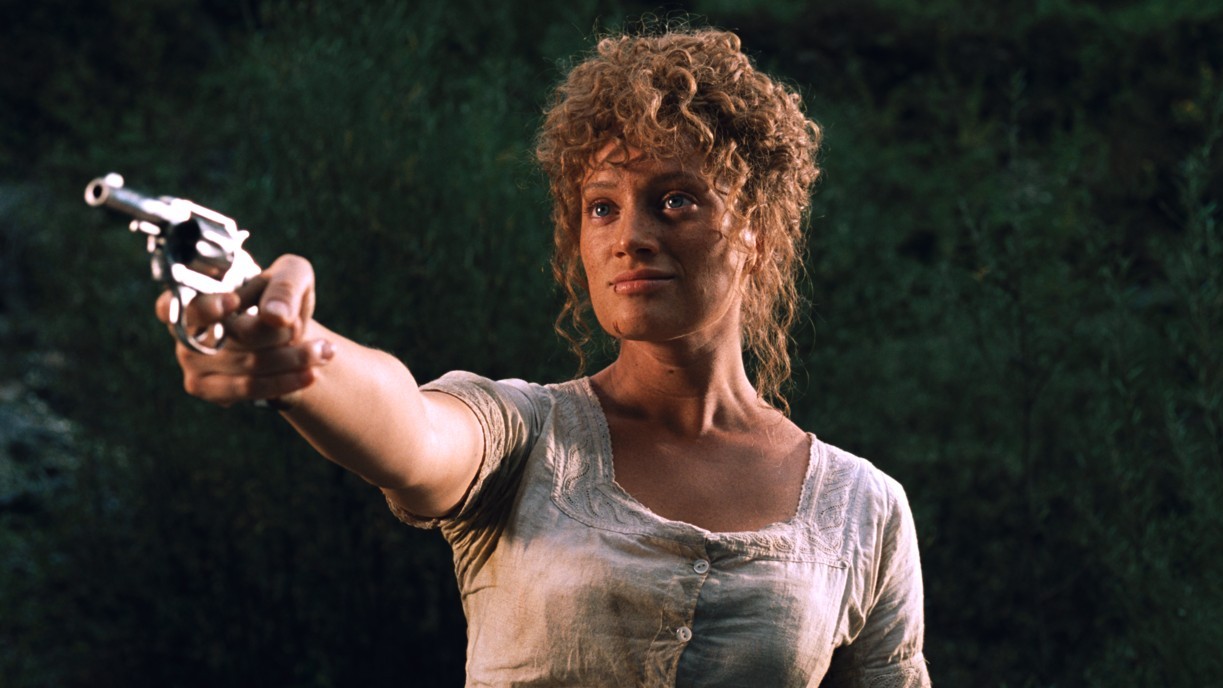The Italian-U.S. co-production Heads or Tails? starts with a re-enactment of an actual historical event: Buffalo Bill (played here by John C. Reilly) and his traveling rodeo show’s early-20th-century visit to Italy. But this freewheeling neo-anti-quasi-western, with its fictional yarn about young lovers (Nadia Tereszkiewicz and Alessandro Borghi) on the run from bounty hunters who encounter revolutionaries and train robbers, eventually goes well beyond printing the legend and wanders off into the realms of magical realism.
The project — directed by Matteo Zoppis and Alessio Rigo de Righi (whose previous effort was The Tale of King Crab) — is nothing if not ambitious, even if its big swings don’t always connect. Nevertheless, there’s a freshness in seeing this kind of horse opera set in Europe itself, as opposed to having southerly locations on the continent pretending to be American landscapes, like they did back in the spaghetti western genre’s 1960s glory days. The whole shebang is so metafictional, it loops back round on itself to become just fiction, but with a few weird bells and whistles.
Heads or Tails?
The Bottom Line
Takes bracing big swings (that don’t always connect).
Venue: Cannes Film Festival (Un Certain Regard)
Cast: Nadia Tereszkiewicz, Alessandro Borghi, John C. Reilly, Peter Lanzani, Mirko Artuso, Gabriele Silli, Giai Garko
Directors: Matteo Zoppis, Alessio Rigo de Righi
Screenwriters: Alessio Rigo de Righi, Matteo Zoppis, Carlo Salsa
1 hour 56 minutes
At least one element rings loud, clear and true throughout and that’s French actress Nadia Tereszkiewicz (Rosalie), who puts meat on the bones of a thinly written lead role. Perhaps because her character, Rosa, is meant to be French like the star herself, she’s not given a lot of Italian dialogue and spends big chunks of screen time looking worried or sad as she stares off into the middle distance, sometimes while riding a horse. But her watchful, alert bearing imbues the character with a sort of unspoken backstory. Meanwhile, her poodle-curly blonde hairdo and bedroom eyes handily evoke Julie Christie in Robert Altman’s McCabe & Mrs. Miller (1971), the OG revisionist western and just the sort of touchstone this film needs to conjure in order make its intentions clear.
Like Christie’s Mrs. Miller, it seems that Rosa was once a sex worker or at least moved in those circles. That’s probably how she ended up being married to Ercole Rupe (Mirko Artuso), a degenerate gambler and the son of a wealthy local landowner Senor Rupe (Gianni Garko, once a spaghetti western star himself in the Sartana series).
After watching Buffalo Bill’s show, the younger Rupe and Bill agree to an equestrian contest to see who is better at breaking wild horses, Italians or Americans. A coin toss (hence the title) decides that the Italians’ champion will be Santino (Borghi), and the handsome wrangler cannot resist the urge to win his contest despite the fact that he was told to throw it by Ercole so the latter could win his bets. Ercole and Santino argue in the stables, but it is the actions of Rosa, who moments before was making doe eyes with Santino, that seal their fate.
Saddling up the white mustang that Santino tamed mere hours ago in the ring, Rosa and Santino ride out together into the dusty dunes beyond Rome, pursued by the elder Rupe’s bounty hunters and Buffalo Bill himself. His flowery, none-too-accurate descriptions of the pursuit become the hyperbolic narration we hear throughout, underscoring for the millionth time in cinema history that fact and fiction seldom align in wild West tales.
Indeed, most of the story beats of the script here (credited to de Righi, Zoppis and Carlo Salsa) could be mapped onto old oaters of yore — from the duplicitous cellmate Santino meets along the way to the anarchistic types who seem to offer the lovers succor in their hijacked train-car encampment but who have their own hidden agendas.
But it’s interesting to be reminded that while Mexican revolutionary Emiliano Zapata of Viva Zapata! fame was urging peasants to revolt at the turn of the 20th century, similar insurrections were going on in the only recently unified Italian state. As in North America, the expansion of the railway system became a locus for conflict, although here it’s local workers who are toiling and singing in the hot sun while laying down tracks, not imported Chinese laborers, or American-born slaves or prisoners. The languages are different but the semiotics stay the same.
When more fantastical elements start to bubble up into the dramatic mix, Heads or Tails? seems less certain of its goals, although the ride remains quite enjoyable all the same. It helps that most of this was shot on photo-chemical film stock, a mix of 35mm, Super 16mm and 16mm, with some digital work seamlessly spliced in as well. Nothing says “western” like honking big grain texture, especially when coupled with lashings of magic-hour backlighting, all deliciously served up by DP Simone D’Arcangelo and his team. Now that’s how the West was won.











